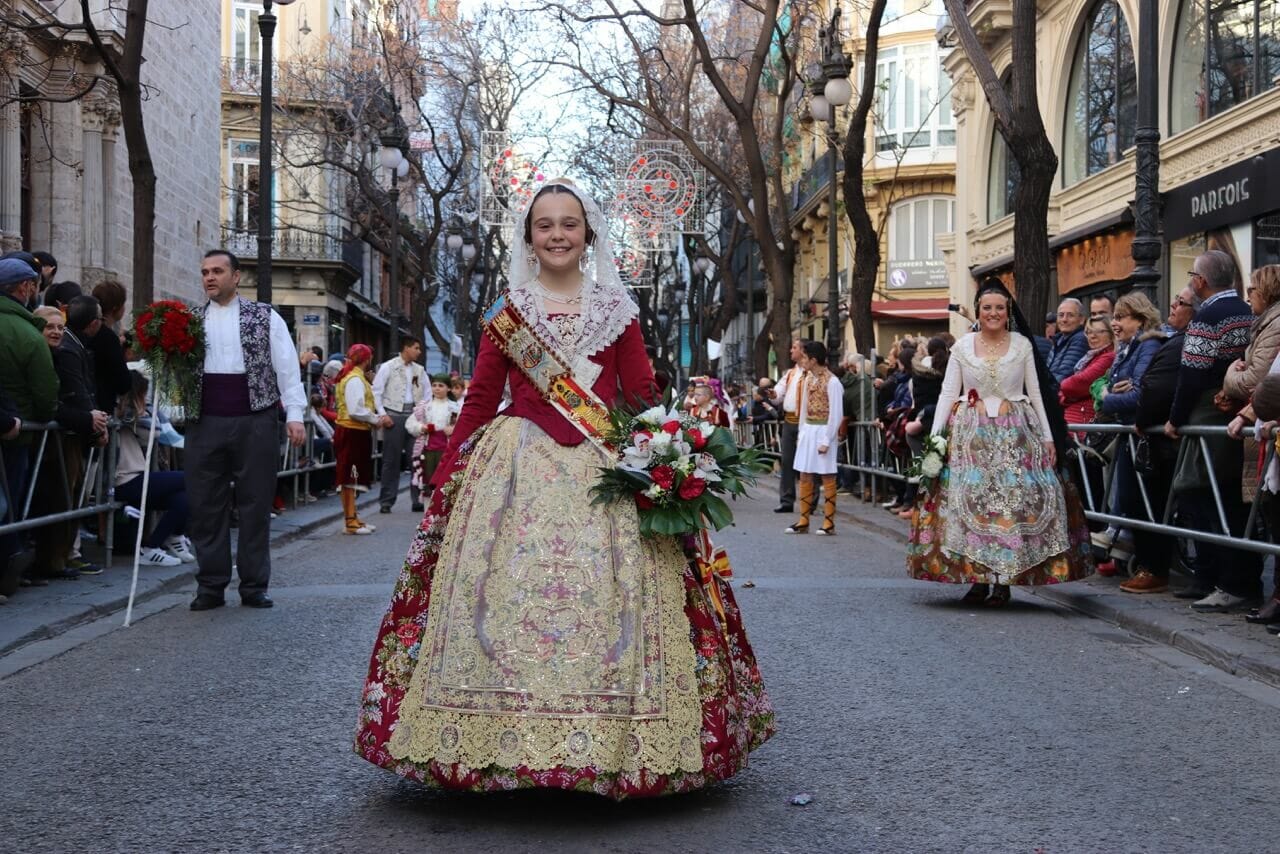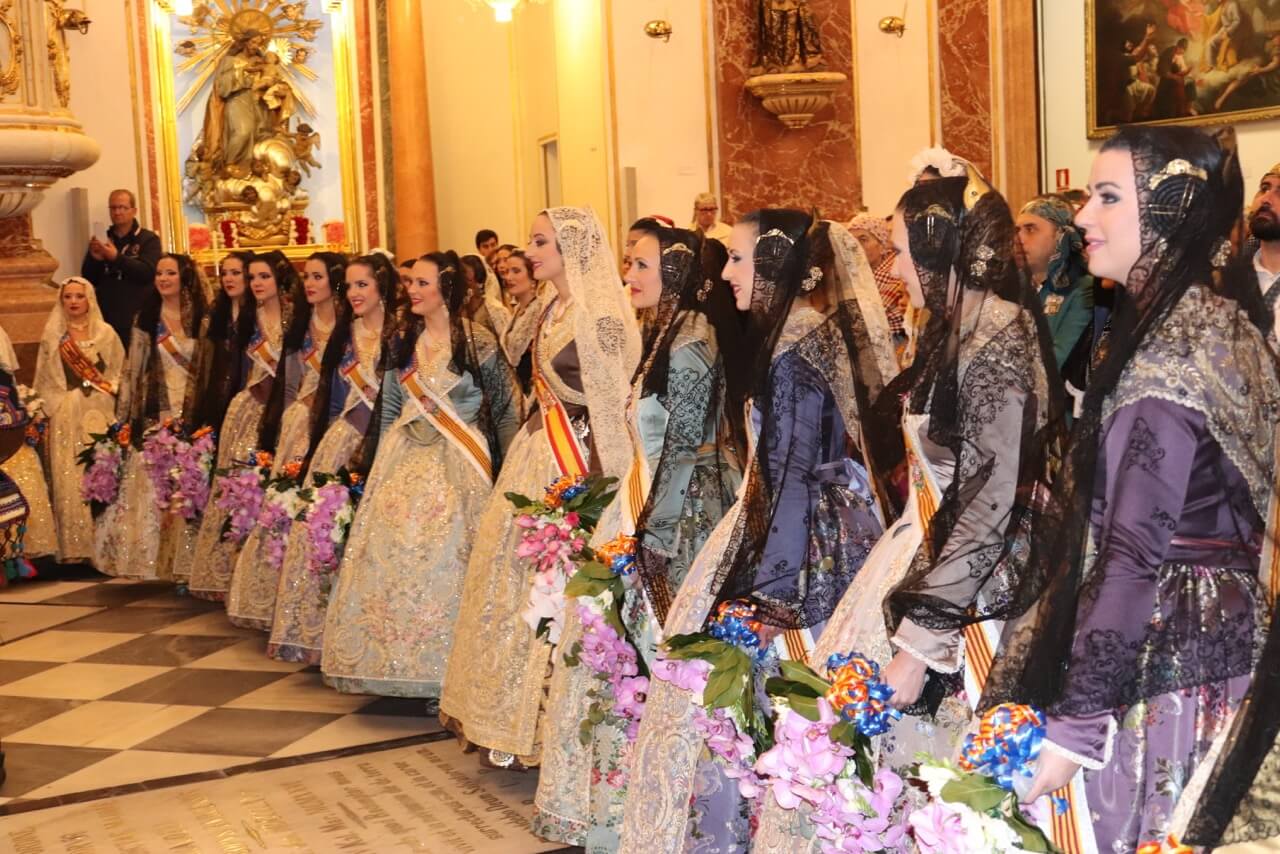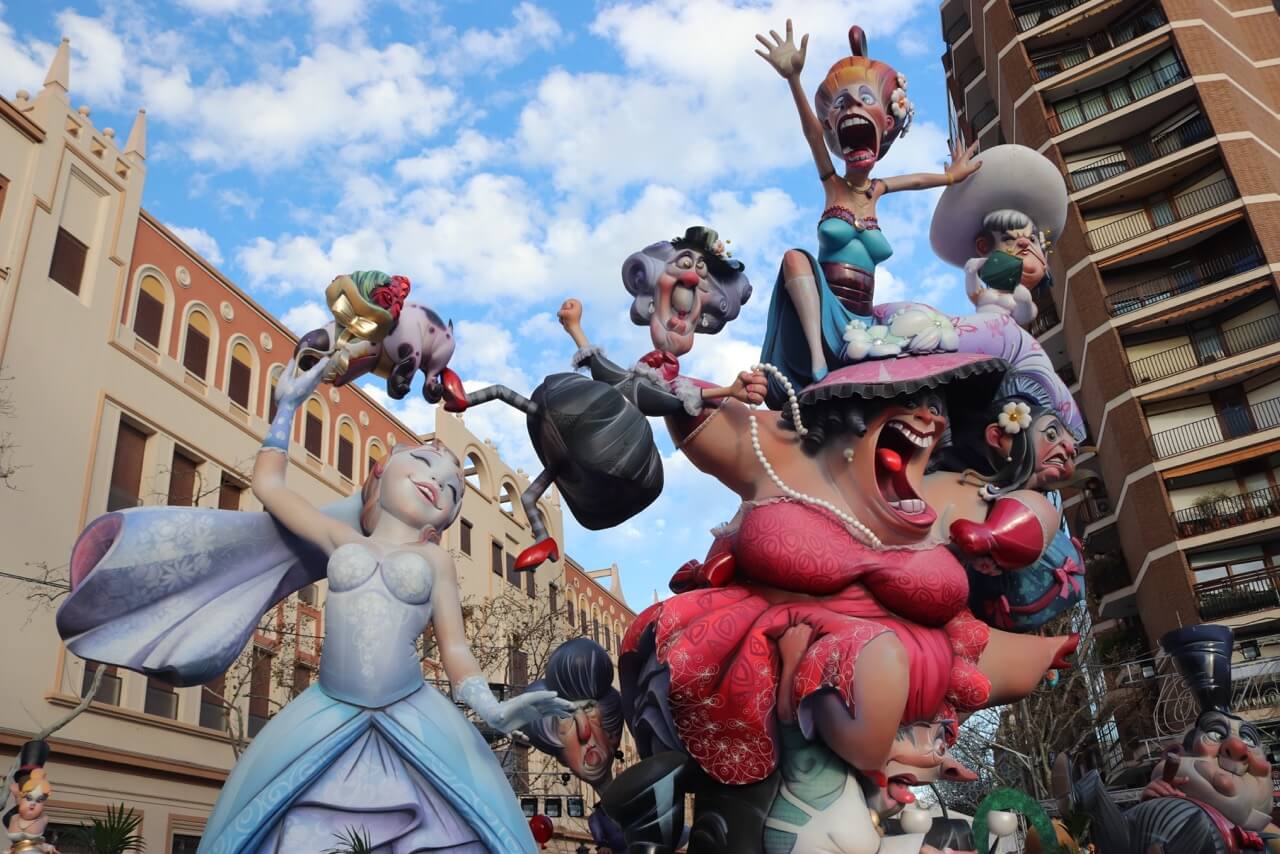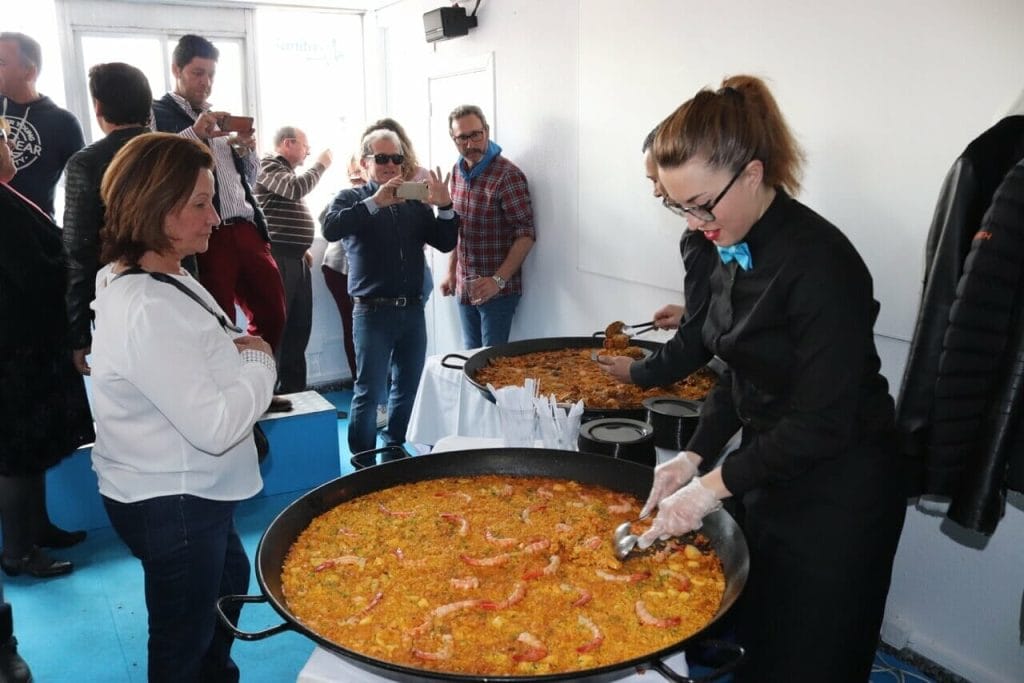Colorful, awe-inspiring monuments, music, lights, traditional costumes, satire, incredible fireworks displays, flowers, emotions, FIRE and a big dose of fun are the main ingredients of one of the most spectacular festivals on earth: The Fallas de Valencia.

Table of Contents
What is “las Fallas de Valencia”?
The word “Fallas” refers to both the festival that occurs from 15 to 19 March every year in Valencia (Spain) and the monuments that are burned during the celebration.
You read that right. They build stunning, huge monuments, some costing up to €200,000, only to burn them all at the end of the festival.
The sculptures are constructed by Falleros artists, a mix of architects, sculptors, painters, carpenters and decorators, who use their imagination and creativity to build majestically towering fallas, that offer comment and criticism on society and events of the recent past.
In total, around 800 Fallas are burned on the night of the 19th, when Valencia is literally on fire.
Having visited Valencia many times, even living there briefly, I finally took the chance in March 2018 to attend the Fallas Festival, which has been included in UNESCO’s list of the Intangible Cultural Heritage.
I loved everything about this festival!!
The music stuck in my mind, I fell in love with the falleras, felt like a child every time I discovered a new Falla, got my jacket singed in the Fire Parade, made new friends during “la masceltà” and also had a finger burned while watching ”la cremà”. And it was all worth it!

History of las Fallas Festival
The Fallas Festival has it origins in the Latin tradition of lighting fires to welcome spring.
Some people believe it started in the Middle Ages when artisans disposed of the broken artifacts and pieces of wood they saved during the winter by burning them to celebrate the spring equinox.
Valencia carpenters used planks of wood called parrots to hang their candles on during the winter and with the coming of the spring and longer days, the parrots were no longer needed, so they burned them.
As the tradition evolved, people started dressing the parrot in clothing so that it resembled a person; later, features identified with well-known persons from the neighborhood were added to criticize their conduct and attitudes.
The modern-day Fallas de Valencia dates back to the 18th century when the Church intervened to change the date of the burning of the parrots to coincide with the celebration of Saint Joseph’s festival, the patron Saint of carpenters.
Nowadays people from all over the world come to see the extraordinary monuments, made of wood, papier-mâché, wax and polystyrene foam, conquer the streets of Valencia.
But the Fallas Festival isn’t only about burning the Fallas, there is music, pyrotechnic shows, traditional costumes, lighting displays, parades and much more.
The Ninot Exhibition
During my first few days in Valencia, I headed to the Principe Felipe Science Museum to see the Exposició del Ninot.
Ninots are individual figures that are part of the Fallas monuments. Although a falla has many ninots, only one selected by each falla committee will be part of this collective exhibition held from the beginning of February to the 15th of March.
There were around 390 adorable, elaborate ninots exhibited on the ground floor level of the museum and every visitor had the chance to vote for the “ninot indultat”, meaning it will not be burned on the night of 19th, but will be honored with a place at the Fallas Museum. The same happens with the ninot infantil (a smaller ninot).

I had a great time attending this exhibition. Some of the ninots were fantastically clever while others delivered strong social satire.
Famous figures like Donald Trump and Kim Jong-un were represented, as well as cartoon characters, Spanish politicians, other celebrities, etc.
Having been impressed by the ninots, I couldn’t wait to see the fallas.
La Plantà
The festival starts on the 15th of March with La Plantà, which means finishing touches when all the fallas have to be completely finished, ready to be visited and entered in the competition.
Walking around the streets of Valencia during the Fallas Festival is like walking in an open-air museum. There are breathtakingly impressive sculptures on every corner of the city.

Each falla is produced by a casal faller, an organized group of people from a neighborhood that promote arts, sports, social integrations and fundraising events during the whole year.
Currently, there are about 750 of these neighborhood associations in Valencia and I was really glad to see the community working together to organize such an important part of the Falla festival.
The Fallas in Valencia have gigantic dimensions, some of them reaching up to 6m (20ft) high, and as a result, the positioning of the final pieces have become a difficult task closely followed by everyone involved in the construction as well as spectators.
I witnessed people making the final touches in some fallas, lifting some pieces with cranes and working through the night to get it done.
Those people are true artists and passionate about the Fallas!

Falleras and Falleros
Another important part of the Fallas in Valencia is the Falleros and Falleras, men and women who dress up in traditional Valencian costumes during the festival.
The first Fallera dresses were inspired by the clothes of peasant women working in the rice fields of Valencia in the 18th and 19th centuries.
Now it’s made from silk produced in the many Valencian workshops.
The dress has a voluminous full-length skirt and a corset and is worn with an ornamental scarf, an apron, and handmade shoes.

Each Falla commission has a Fallera Mayor and a Fallera Mayor Infantil, a ritual role that serves as a symbol of the festival.
One of them is chosen as the Fallera Mayor of Valencia, who will preside over all major events.

The Fallero usually wear a scarf (or a hat) on their head, a white shirt, a vest, pantaloons (saragüells), and rope-soled sandals on their feet. They also wear a faja (a sash worn as a belt), which indicates their rank.
Sometimes they also wear a manta (a piece of coarse cloth that was formerly used as a blanket but now transformed into an ornamental piece of clothing).

I adored seeing the little boys and girls dressed in their pretty traditional costumes, the elegant falleros strutting around, and the falleras’ shiny golden dresses reflecting their own beauty.
The Flower Offering
One of the greatest moments of expression of religious devotion during the Fallas de Valencia, is the Ofrenda (the Flower Offering Parade).
Thousands of Falleras and Falleros depart from their Falla Committees, accompanied by their own bands and carrying flowers to dress the robe of an immense image of Our Lady of the Forsaken, the patron saint of Valencia.
The statue stands in the city center on the eponymous plaza, opposite the Basilica.

During those two days, Valencia’s streets are filled with grandeur and elegance.

Seeing the many falleras and falleros on the streets was so surreal that it felt as if I were living in medieval times. I’d only remember that it’s actually the 21st century when they used their cellphones to take selfies.

While they wait for their turn to march towards the Basilica, the falleros and falleras were having fun, singing and dancing with their bands.
But, as they approached the square, most of them became quiet and I could see that they were immensely moved by the sight of the saint.

As the time passed, the colossal image and its surroundings were completely covered with flowers. It was a breathtaking expression of the Valencian people’s devotion.

La Mascletà
From the 1st to 19th of March thousands of Valencians and tourists gather every day at 2:00 PM at the Plaza del Ayuntamiento to see a particular pyrotechnical show called La Mascletà.
Different pyrotechnicians present a combination of rhythmic fireworks sequences, that seem more like a concert than an ordinary firework display.
Every presentation finishes with a terremoto (earthquake), when hundreds of “masclets” explode on the ground simultaneously.
I‘ve never seen a firework display like this before and enjoyed it so much that I saw it three times.

But La Mascletà is much more than an incomparable firework display, it’s also one of the times that friends and families can reunite to celebrate the Fallas in Valencia, have some drinks, and eat Spanish tapas and the most renowned Valencian dish, paella.
The Gunpowder Passion
Valencian’s love gunpowder!
You can see their passion in the children playing with fireworks on the streets all day long during the festival and in the huge crowds attending the mascletàs or the pyrotechnical shows that take place at night (on the 15th and 19th at Plaza del Ayuntamiento, and on the 16th, 17th and 18th on the old Turia riverbed).
The most important is the Nit del Foc (Night of Fire) that occurs on the night of the 18thas it’s a prelude to the main day of Fallas.
Seeing the young people playing with fireworks on the streets reminded me of when I was a kid in Bahia, Brazil, where we used to do that during the Saint John’s festivities.
I was terrifically impressed by the pyrotechnical shows on Plaza del Ayuntamiento. The lights, the colors, the whistles, the intensity, the choreography and the noise were fantastic.
Cavalcada del Foc
There are several parades during the Fallas in Valencia, but for me none beat the Cavalcada del Foc (The Fire Parade).
It’s a vibrant, exhilarating celebration of fire with people in costumes, gigantic intriguing mechanisms, rockets, streets performances, live music, fireworks, gunpowder and a big fiesta.
I had so much fun on the Cavalcada del Foc!!
The drums, the big metallic turtle spitting fire, the street performances and of course the fireworks were just phenomenal.
I was so entranced by this parade that I didn’t even notice my jacket getting a bit burned….

La Cremà
The Grand Finale and the climax of the Fallas Festival in Valencia is La Cremà (the burning) when the fallas in the city are burned at midnight on the 19th of March.
The winner of the Special Section is burned at 12:30 AM and the municipal Falla, constructed by the city hall, is burned at 1:00 AM.
So, the spirit of the pagan rite of burning everything that was unusable on bonfires, live on in this extravagant burning of the enormous, magnificent fallas scattered all over Valencia.

One of the toughest decisions for me during the festival was to choose which falla I should see burning.
Most of the popular fallas were in narrow streets surrounded by buildings, which made it difficult to get close to amongst the crowds, so I decided to attend the burning on Plaza del Ayuntamiento at 1:00 AM.
The municipal fall this year was entitled “Equilibrio Universal” and its purpose was to question the values that sustain our modern society.
I arrived at Plaza del Ayuntamiento at 9:00 PM, 4h in advance, to see the burning of the most important fall in Valencia.
It was windy and quite cold, and I wasn’t really dressed appropriately. People started arriving around 10:00 PM and among them there was a Bolivian family that I spent most of the time chatting to, who kindly gave me a bench and blanket to keep me warm.
After waiting more than 4 hours, the burning ritual of the 170.000 euros falla finally started to the clamor of hundreds of people.I was so excited!
First, the announcement, followed by the majestic fireworks in perfect synchronization with rockets exploding clockwise around the square, then the music and finally the burning.
The big four faces representing humankind was engulfed in flames and the public cheered enthusiastically.
Press the right arrow to see all pictures.
Even though firefighters were controlling the fire, it became very big quickly and the wind blew some ashes and sparks in the direction of where I was standing.
People started screaming and running, and when I looked back, there was no one behind me. This was when I realized that the Bolivian mother had opened up an umbrella to protect her daughters just as a piece of debris fell on my little finger….
After 30 min, most of the falla had gone, as had the public presence on the square.
Walking back home, the streets of Valencia were very quiet, clean and empty of the splendor and colors of the fallas.
Apart from the tradition and unique grandeur, the Fallas Festival is also a lesson in detachment.
Over 1,5 million euros were invested in magnificent, captivating monuments that are made to be burned. It’s the fallas’ fate and main purpose, to be created to “die”. As it is ours…
Safe travels and enjoy the festival.
More Pictures of the Fallas de Valencia 2018
The winner of the Special Section (a group of the most prestigious and wealthy Fallas commissions of Valencia)




Second Prize: Falla Cuba-Literat Azorín (Vicente Manuel Martínez Aparicio)

Ingenuity and Charm winner of the Special Section: Libertat (Antonio Pérez Mena)


The Municipal Falla, Equilibrio Universal (Latorre and Sanz Artesanos)

Watch Video
More posts about Valencia that might interest you:
- 7 Best Things to Do in Valencia
- Itineraries for 1, 2 and 3 Days in Valencia (With Maps)
- If the Bulls Aren’t Injured is that Acceptable to Watch a Bullfight?
- Final of “Los Recortes”, Valencia – Video
I always recommend buying travel insurance, which can literally be your lifeline if something happens to you and if your luggage is lost or stolen.
I always use World Nomads Travel insurance for independent travelers. It’s easy to buy, extend & claim online, even after you’ve left home.
Get yours here.
Visiting Valencia During the Fallas Festival
Where’s Valencia?
Valencia, the capital of the autonomous community of Valencia and the third-largest city in Spain after Madrid and Barcelona, is located on the east coast of Spain, around 300 Km (186 mi) of Madrid, Spain’s capital (check map here).
How to get there?
There is an international airport in Valencia, and some of the airlines operating flights to Valencia are British Airways, Easyjet, Vueling, Iberia, Air Europa and Ryanair.
You can book your flights with Skyscanner, which is the website that I use and trust.
You can also get to Valencia by train from Madrid and Barcelona with Renfe, or by bus with Avanza or Alsa.
Best Time to Visit Valencia
Valencia has a Mediterranean climate with consistently pleasant weather. Average high temps range from 15 C (59 F) in the wintertime to 30C (85F) in the height of summer.
You can visit Valencia all year round, but if you want to see the Fallas Festival you must go between 15th and 19th of March.
Where to stay?
I stayed at Twenty Granada and if you’re looking for hotels in Valencia, I also recommend:
- Budget: Cantagua Hostel, Hostal Antigua Morellana and The River Hostel.
- Great Cost/Benefit: Sohotel Ruzafa, Hi Valencia Boutique and Venecia Plaza Centro
- Luxury: Vincci Lys, Hotel Medium Valencia and One Shot Palacio Reina Victoria 04
Valencia Tours
Extra Tips
- If you want to save some money during your stay in Valencia, buy the Valencia Tourist Card. With this card, you travel for free on buses, metros and trams and get free entry to municipal museums and monuments. The cheapest card, the 24h one, cost €15. Just the metro from the airport to the city center costs € 4,5.
- Because the Plaza del Ayutamiento gets really crowded during La Mascletà, I recommend getting there at least an hour and a half in advance, if you cannot watch it from a balcony of one of the buildings in the square. I watch it from Balcon Fallas one day and I loved it. They provided a great service and offered different options such as only cocktails, tapas or free buffet.
Don’t forget to save these pins for later 😉
- Book Your Flight Find deals on airlines on my favorite search engine: Skyscanner. Be sure to read my How to find cheap flights article.
- Rent A Car Rental Cars is a great site for comparing car prices to find the best deal.
- Book Accommodation Booking.com is my favorite hotel search engine. But Hotels.com and Hilton Hotels have very interesting reward programs.
- Protect Your Trip Don’t forget travel insurance! I always use World Nomads for short-term trips and SafetyWing for long-term ones. Find out why Travel Insurance: Much More Than a Precaution, a Necessity.
- Book Tours in Advance Book unforgettable experiences and skip-the-line tickets with GetYourGuide or Viator .
- Book Ground Transportation BookaWay offers a stress-free experience with secure payments and no hidden fees. You pay online and receive your itinerary by email.
- Luggage Solutions Rent your luggage with Cargo or if you need to drop off your own luggage and enjoy your time without dragging it all over a city, find a LuggageHero shop here.
- Get a Travel Card Revolut Card is a pre-paid debit card that enables cash machine withdrawals in 120 countries. I’ve been using my Revolut Card for over a year and never paid foreign-transaction fees again. Get your Revolut Card with free shipping here.
- Packing Guide Check out my How to Pack a Carry-on Luggage For a Five-month Trip to help you start packing for your trip. Don’t forget your camera, chargers and other useful travel accessories. World Nomads provides travel insurance for travelers in over 100 countries. As an affiliate, we receive a fee when you get a quote from World Nomads using this link. We do not represent World Nomads. This is information only and not a recommendation to buy travel insurance.












Hi, I noticed you have a table of contents at the top of the page, where did you get the plugin? Thanks
I use the Easy Table of Content puglin 😉